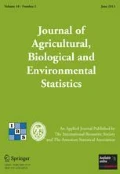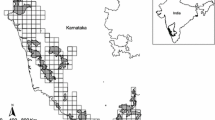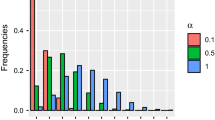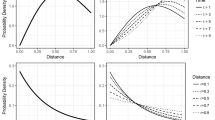Abstract
We present a unified framework for modeling bird survey data collected at spatially replicated survey sites in the form of repeated counts or detection history counts, through which we model spatial dependence in bird density and variation in detection probabilities due to changes in covariates across the landscape. The models have a complex hierarchical structure that makes them suited to Bayesian analysis using Markov chain Monte Carlo (MCMC) algorithms. For computational efficiency, we use a form of conditional autogressive model for modeling spatial dependence. We apply the models to survey data for two bird species in the Great Smoky Mountains National Park. The algorithms converge well for the more abundant and easily detected of the two species, but some simplification of the spatial model is required for convergence for the second species. We show how these methods lead to maps of estimated relative density which are an improvement over those that would follow from past approaches that ignored spatial dependence. This work also highlights the importance of good survey design for bird species mapping studies.
Similar content being viewed by others
References
Alho, J. M. (1990), “Logistic Regression in Capture-Recapture Models,” Biometrics, 46, 639–649.
Alldredge, M. W., Pollock, K. H., Simons, T. R., Collazo, J. A., and Shriner, S. (2007), “Time of Detection Method for Estimating Abundance from Point Count Surveys,” The Auk, 124, 653–664.
Alsop, F. J. (1991), Birds of the Smokies, Gatlinburg, TN: Great Smoky Mountains Natural History Association.
Banerjee, S., Carlin, B. P., and Gelfand, A. E. (2004), Hierarchical Modeling and Analysis for Spatial Data, Boca Raton, FL: Chapman and Hall.
Besag, J. (1974), “Spatial Interaction and the Statistical Analysis of Lattice Systems,” Journal of the Royal Statistical Society, Series B, 36, 192–236.
Coull, B. A., and Agresti, A. (1999), “The Use of Mixed-Logit Models to Reflect Heterogeneity in Capture-Recapture Studies,” Biometrics, 55, 294–301.
Cressie, N. (1993), Statistics for Spatial Data (2nd ed.), New York: Wiley.
Diggle, P. J., Tawn, J. A., and Moyeed, R. A. (1998), “Model-Based Geostatistics” (with discussion), Applied Statistics, 47, 299–350.
Dorazio, R. M., Jelks, H. L., and Jordan, F. (2005), “Improving Removal-Based Estimates of Abundance by Sampling a Population of Spatially Distinct Subpopulations,” Biometrics, 61, 1093–1101.
Dorazio, R. M., and Royle, J. A. (2003), “Mixture Models for Estimating the Size of a Closed Population When Capture Rates vary Among Individuals,” Biometrics, 59, 351–364.
Farnsworth, G. L., Pollock, K. H., Nichols, J. D., Simons, T. R., Hines, J. E., and Sauer, J. R. (2002), “A Removal Model for Estimating Detection Probabilities From Point-Count Surveys,” The Auk, 119, 414–425.
Forsyth, D. M., Link, W. A., Webster, R., Nugent, G., and Warburton, B. (2005), “Nonlinearity and Seasonal Bias in an Index of Brushtail Possum Abundance,” Journal of Wildlife Management, 69, 976–984.
Gelfand, A. E., and Vounatsou, P. (2003), “Proper Multivariate Conditional Autoregressive Models for Spatial Data Analysis,” Biostatistics, 4, 11–25.
Gelman, A. (2006), “Prior Distributions for Variance Parameters in Hierarchical Models” (comment on article by Browne and Draper), Bayesian Analysis, 1, 515–534.
Gelman, A., Carlin, J. B., Stern, H. S., and Rubin, D. B. (2004), Bayesian Data Analysis (2nd ed.), Boca Raton, FL: Chapman and Hall.
Geman, S., and Geman, D. (1984), “Stochastic Relaxation, Gibbs Distributions and the Bayesian Resolution of Images,” IEEE Transactions on Pattern Analysis and Machine Intelligence, 6, 721–741.
Hastings, W. K. (1970), “Monte Carlo Sampling Methods using Markov Chains and their Applications,” Biometrika, 57, 97–109.
Holzmann, H., Munk, A., and Zucchini, W. (2006), “On Identifiability in Capture-Recapture Models,” Biometrics, 62, 934–936.
Hrafnkelsson, B., and Cressie, N. (2003), “Hierarchical Modeling of Count Data with Application to Nuclear Fall-Out,” Environmental and Ecological Statistics, 10, 179–200.
Huggins, R. M. (1989), “On the Statistical Analysis of Capture Experiments,” Biometrika, 76, 133–140.
Lichstein, J. W., Simons, T. R., Shriner, S. A., and Franzreb, K. E. (2002), “Spatial Autocorrelation and Autoregressive Models in Ecology,” Ecological Monographs, 72, 445–463.
Link, W. A. (2003), “Nonidentifiability of Population Size from Capture-Recapture Data with Heterogeneous Detection Probabilities,” Biometrics, 59, 1123–1130.
McShea, W. J., and Rappole, J. H. (1997), “Variable Song Rates in Three Species of Passerines and Implications for Estimating Bird Populations,” Journal of Field Ornithology, 68, 367–375.
Norris, J. L., and Pollock, K. H. (1996), “Nonparametric MLE Under Two Closed Capture-Recapture Models with Heterogeneity,” Biometrics, 52, 639–649.
Otis, D. L., Burnham, K. P., White, G. C., and Anderson, D. R. (1978), “Statistical Inference from Capture Data on Closed Animal Experiments,” Wildlife Monographs, 62, 1–135.
Pinder, J. E., Kroh, G. C., White, J. D., and Basham May, A. M. (1997), “The Relationships Between Vegetation Type and Topography in Lassen Volcanic National Park,” Plant Ecology, 131, 17–29.
Pledger, S. (2000), “Unified Maximum Likelihood Estimates for Closed Capture-Recapture Models Using Mixtures,” Biometrics, 56, 434–442.
— (2005), “The Performance of Mixture Models in Heterogeneous Closed Population Capture-Recapture,” Biometrics, 61, 868–873.
Pollock, K. H., Nichols, J. D., Brownie, C., and Hines, J. E. (1990), “Statistical Inference for Capture-Recapture Experiments,” Wildlife Monographs, 107.
Ralph, J. C., Droege, S., and Sauer, J. R. (1995), “Managing and Monitoring Birds Using Point Counts: Standards and Applications,” in Monitoring Bird Populations by Point Counts, eds., J. C. Ralph, J. R. Sauer, and S. Droege, U.S. Forest Service General Technical Report PSW-GTR-149, pp. 161–168.
Royle, J. A. (2004), “N-mixture Models for Estimating Population Size from Spatially Replicated Counts,” Biometrics, 60, 108–115.
Royle, J. A., and Dorazio, R. M. (2006), “Hierarchical Models of Animal Abundance and Occurrence,” Journal of Agricultural, Biological, and Environmental Statistics, 11, 249–263.
Royle, J. A., Link, W. A., and Sauer, J. R. (2002), “Statistical Mapping of Count Survey Data,” in Predicting Species Occurences: Issues of Accuracy and Scale, eds. J. M. Scott, P. J. Heglund, M. L. Morrison, J. B. Haufler, M. G. Raphael, W. A. Wall, and F. B. Samson, Washington: Island Press.
Seber, G. A. F. (1982), The Estimation of Animal Abundance and Related Parameters (2nd ed.), New York: Macmillan.
Shriner, S. A. (2001), “Distribution of Breeding Birds in Great Smoky Mountains National Park,” unpublished PhD thesis, North Carolina State University.
Shriner, S. A., Simons, T. R., and Farnsworth, G. L. (2002), “A GIS-based Habitat Model for Wood Thrush, hylocichla mustelina, in Great Smoky Mountains National Park,” in Predicting Species Occurences: Issues of Accuracy and Scale, eds. J. M. Scott, P. J. Heglund, M. L. Morrison, J. B. Haufler, M. G. Raphael, W. A. Wall, and F. B. Samson, Washington: Island Press.
Simons, T. R., Alldredge, M. W., Pollock, K. H., and Wettroth, J.M. (2007), “Experimental Analysis of the Auditory Detection Process on Avian Point Counts,” The Auk, 124, 986–999.
Simons, T. R., Farnsworth, G. L., and Shriner, S. A. (2000), “Evaluating Great Smoky Mountains National Park as a Population Source for the Wood Thrush,” Conservation Biology, 14, 1133–1144.
Simons, T. R., Shriner, S. A., and Farnsworth, G. L. (2006), “Comparison of Breeding Bird and Vegetation Communities in Primary and Secondary Forests of Great Smoky Mountains National Park,” Biological Conservation, 129, 302–311.
Spiegelhalter, D., Thomas, A., Best, N., and Lunn, D. (2003), WinBUGS User Manual, Version 1.4.
Thomas, A., Best, N., Lunn, D., Arnold, R., and Spiegelhalter, D. (2004), GeoBUGS User Manual, Version 1.2 September 2004.
Wikle, C. (2002), “Spatial Modelling of Count Data: A Case Study in Modelling Breeding Bird Survey Data on Large Spatial Domains,” in Spatial Chester Modelling, eds. A. B. Lawson, and G. T. Denison, Boca Raton: Chapman and Hall/CRC.
Wyatt, R. J. (2002), “Estimating Riverine Fish Population Size from Single-and Multiple-Pass Removal Sampling using a Hierarchical Model,” Canadian Journal of Fisheries and Aquatic Science, 59, 695–706.
Zippen, C. (1956), “An Evaluation of the Removal Method of Estimating Animal Population,” Biometrics, 12, 163–189.
Author information
Authors and Affiliations
Corresponding author
Rights and permissions
About this article
Cite this article
Webster, R.A., Pollock, K.H. & Simons, T.R. Bayesian spatial modeling of data from avian point count surveys. JABES 13, 121–139 (2008). https://doi.org/10.1198/108571108X311563
Received:
Revised:
Issue Date:
DOI: https://doi.org/10.1198/108571108X311563




